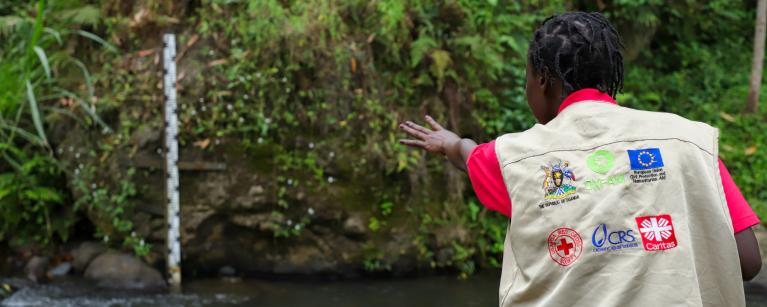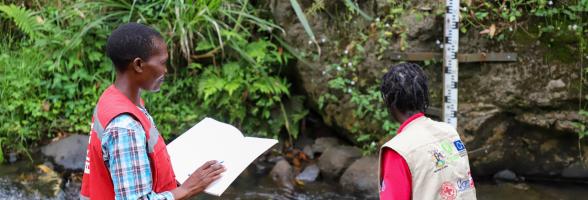At exactly 6:30 am, 36-year-old teacher Naome Khanakwa rushes out of her home for work.
It is still early for her teaching job, but instead, she heads towards Diisi River, which circles around Makerere village, Shimuma Parish, Sironko district. Out of passion and a commitment to her community, she performs the daily task of taking readings from the river gauge installed by Uganda Red Cross Society (URCS) under an European Civil Protection and Humanitarian Aid Operations (ECHO) -funded, Oxfam-led consortium working to strengthen disaster preparedness and response in the Mt Elgon region.
Khanakwa, who teaches English at the nearby Bumumulo Primary School, is part of a volunteer team of six, two of whom were trained to take river gauge readings under the project to monitor the water levels. River Diisi has been prone to flooding, with the most recent disaster happening in 2020 when the river broke its banks, leading to the loss of lives and the destruction of property and infrastructure.
The river gauge was installed to help communities get early alerts on possible flooding. A gauge is a simple device used to record the water level. It is an enameled metal plate with number values measured in meters installed at a particular point on the river bank. This specific river gauge takes readings up to 200 meters.
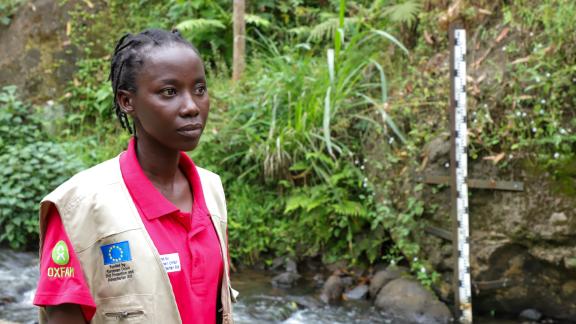
Naume Khanakwa , a volunteer river gauge reader in Makerere village, Shimuma Parish, Sironko district supports her community by taking river gauge readings. Photo By Ivan Rackara | Oxfam in Uganda
Having taken the readings, Khanakwa records her findings, and if she determines that the water levels are high (between 100-150 meters), she alerts the local community radio using a mobile phone, also provided by the project. The community radio presenter, in turn, issues an alert to the community advising them not to cross or carry on any activities near the river. If the water levels are anticipated to continue rising, the community is notified of possible early evacuation of some areas.
A red flag is hoisted near the rivers to warn people not to cross while a yellow flag is hoisted whenever the water levels are low and it's safe to cross.
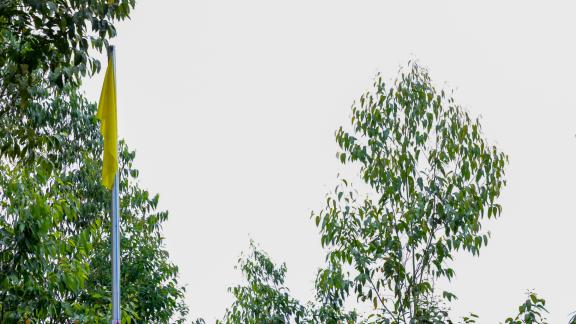
Yellow flag which is hoisted whenever the water levels are low. Photo By Ivan Rackara | Oxfam in Uganda
These early warning messages or signs are backed up by the members of the village disaster management committee, who physically reach out to high-risk community members to pass on the message since the radios don’t cover the whole village. The signs are also communicated to the Sub County Disaster Management Committee who also communicate it to the District Disaster Management Committee for any technical or financial preparedness action towards the community.
In a day, the two river gauge readers take four readings, with Khanakwa taking the first reading at 6:30 am, followed by her colleague Victoria, who takes the midday reading. Since the school Khanakwa teaches at is less than 10 minutes away from the river, she uses the school lunch break to take the next reading before they meet at 6:00 pm to take the last reading jointly.
It’s an unsalaried job with a huge responsibility, but Khankawa is motivated to serve her community as best as she can.
“I feel happy when my community members are safe, especially my students,” she says. She adds that it’s also her way of ensuring her family is safe because whenever disasters happen, her family is also affected. I use my teaching to educate the children about the environment and safety.
Khanakwa, who is also a guardian to 3 children, hopes that through her voluntary service, she can be a good example to the young children in the community, who she hopes will be able to grow up committed to community service.
“I feel happy when my community members are safe, especially my students,” she says. She adds that it’s also her way of ensuring her family is safe because whenever disasters happen, her family is also affected. I use my teaching to educate the children about the environment and safety”
Setting up the River Gauges
The Mt Elgon region of Uganda is often synonymous with natural disasters like floods and landslides, mainly due to natural factors like heavy rainfall and the terrain. Sadly, these recurring disasters have left many lives lost and property destroyed. Building on ongoing government efforts, existing local structures, and previous experiences of other actors in the country, Oxfam, Catholic Relief Services (CRS), Caritas Tororo, and the Uganda Red Cross Society (URCS) designed a project to strengthen community-led and locally-owned disaster preparedness actions. Funded by the European Union Civil Protection and Humanitarian Aid Operations (ECHO), the project is implemented in the districts of Bududa, Butaleja, Mbale, Namisindwa, and Sironko in the Mount Elgon region in Eastern Uganda.
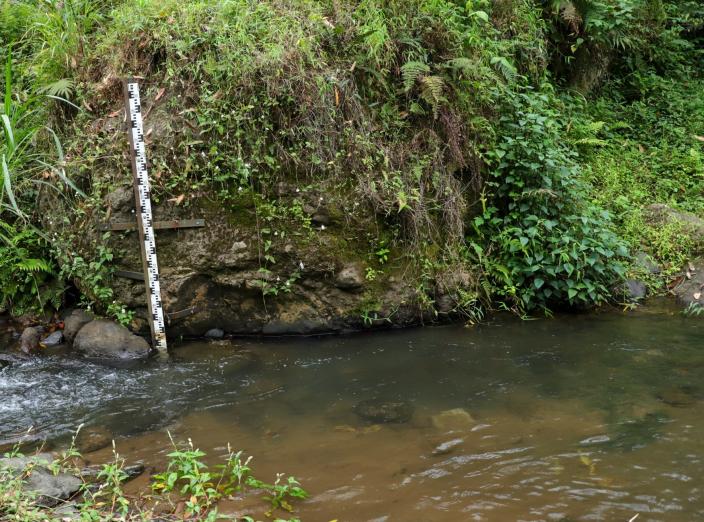
The Red Cross set up the River gauge at River Diisi under an Oxfam-led the consortium working on the strengthening community-led and locally-owned disaster preparedness actions project. Photo By Ivan Rackara | Oxfam in Uganda
The project has been building effective linkages between early warning and early action and supporting gender-sensitive district contingency planning in highly vulnerable or exposed districts.
The river gauges are among the interventions set up to heighten early warning and action among several communities.
According to Brenda Atero, a Red Cross project assistant, before the gauges were installed in 2023, the locals often used indigenous ways to determine water levels. While they sometimes helped, they weren’t as reliable. “They would often monitor the water levels by observing the height of the bigger rocks at the river,” she says.
““They would often monitor the water levels by observing the height of the bigger rocks at the river.””
This wasn’t reliable partly because algae and other water weeds often develop on the rocks and conceal the water levels. There was also no committed person regularly checking the water levels, and when they did, timely and wide dissemination of the early warning messages was difficult.
The project brought in the river gauges, committed gauge readers, and effective ways like mobile phones, megaphones, community radios, Red Cross early action teams, and CRS volunteers to ensure everyone receives the early warning messages promptly to take action.
The community does not just wait for these warnings but has also received training in anticipatory actions and has conducted early action activities such as clearing including clearing trenches, digging drainage channels, clearing water passages by digging contours, and rehabilitating footbridges.
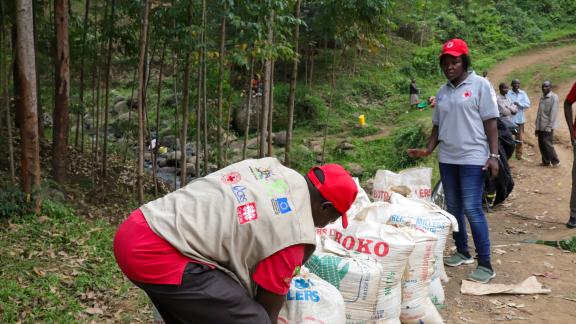
Brenda Atero, Red Cross Project Assistant supervises the filling of sandbags. These sandbags are used as a barrier to control floods. Photo By Ivan Rackara | Oxfam in Uganda
In all these, Brenda emphasizes that the community is at the center. “We train the community on how to identify the disasters and the hot spots, and our work as Uganda Red Cross Society is to guide them on which actions solve the identified problem. The entire process is consultative, which gives community members a sense of ownership of the initiatives being implemented in disaster risk reduction,” said Brenda Atero.
The project has installed 14 river gauges across the implementation districts of Sironko, Mbale, Namisindwa, Butaleja and Bududa. The gauges have been practical through the tireless effort of volunteers like Khanakwa.
However, one of the drawbacks of the river gauges is that the readings are not taken beyond 6 pm. “Currently, the volunteers cannot take readings past 6 pm. This leaves a huge window of vulnerability if the water levels rise very high at night, leading to floods.,” says Brenda.
There’s a hope that if the river gauges were digitized, it would improve the effectiveness of the early warning initiatives as they could take readings regularly, including at night.
By Ivan Rackara - Communications Graduate Trainee (Oxfam in Uganda)
